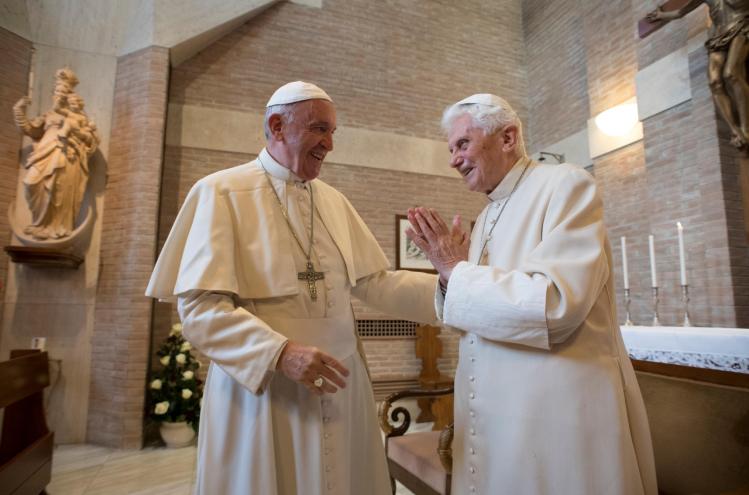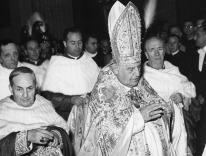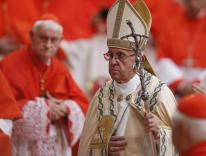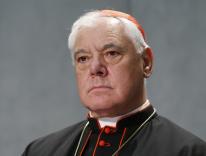
A couple of weeks ago La Croix International published an important article by Massimo Faggioli under the title, “The Peculiar Benedict Complex.” It explored some of the psychological and ecclesiological effects that Benedict XVI’s resignation from the papacy has had on the Church.
Faggioli, an LCI featured columnist and Commonweal contributing editor who now teaches historical theology at Villanova University in Philadelphia, wrote:
“The post-Benedict Church has only just begun to deal with the newly created institution of the ‘Bishop-emeritus of Rome’. The ‘Benedict complex’ tends to pit Pope Francis against his predecessor in a rivalry, if not a hostile relationship, which ends in a zero-sum game.”
A prominent member of the so-called “Bologna School” of ecclesiastical history (especially of the reforming nature of the Second Vatican Council), Faggioli argued that this new “Benedict complex” was being advanced by certain journalists and—my words now, not his—Catholics nostalgic for a rigid doctrinal conformity and black-and-white clarity that they, rightly or wrong, identify with the theology of the former pope.
“Even though some in Benedict XVI’s entourage have used the ‘pope emeritus’ to further their own personal agenda (and this is a serious issue), the ‘theological-industrial complex’ is not primarily a product of the theology of Ratzinger or his followers (the Ratzingerians),” Faggioli wrote.
Yes. And no.
Long before serving as Bishop of Rome (2005-2013), Joseph Ratzinger steadily consolidated his mark in contemporary ecclesiastical history as arguably the single most influential theologian in the post-Vatican II Church.
Beginning in late 1981 when John Paul II appointed him prefect of the Congregation for the Doctrine of the Faith, Ratzinger’s carefully circumscribed theological views gradually became all but normative for the rest of the Catholic world. The Bavarian prefect was, in all but a few important areas, the theological spinal cord of the long, restorationist pontificate of the now-sainted Polish pope.
Then, during his own eight-year pontificate, Benedict XVI went even further to impose some of his most controversial positions on the entire Church. One of the most serious was the publication of the motu proprio, Summorum Pontificum, which gave priests unfettered permission to celebrate the Eucharist and the other sacraments in the Tridentine Rite.
One effect of this motu proprio has been the deepening of divisions between reform-minded Catholics who have embraced Vatican II and the self-described traditionalists who have contested many of the reforms that followed the Council.
But another consequence of the document has been the legitimization of the neo-Tridentinists (some who are quasi-Lefebvrists)—priests and entire religious orders that had been on the fringes of the Church in the decades following the council they so dislike.
But once he was pope Benedict gave them new prominence, even appointing some of their most ardent supporters to key posts. There is no better (or worse) example than the American ultra-traditionalist, Raymond Burke. The former pope made the man who today is one of Pope Francis’s most prominent critics head of the Vatican’s top court in 2008. Benedict then made him a cardinal two years later.
And this is where one must begin to politely disagree with Massimo Faggioli when he seems to exonerate Ratzinger and his devotees from any responsibility for creating the “Benedict complex.”
In fact, responsibility lies squarely with the former pope. And if Jorge Mario Bergoglio, SJ had not been elected Bishop of Rome in 2013, this “complex” would likely be even worse today.
Let’s refresh our memories.
When Benedict XVI abdicated the papacy at the end of February that year he unilaterally made a series of decisions that had the real potential of inhibiting the pontificate of his then still-unknown successor.
Before the conclave even got started, he decided to take the title “Pope-emeritus”. Almost every respected canon lawyer, theologian and Church historian immediately voiced perplexity at the choice. They noted that the proper title should be Bishop-emeritus of Rome.
Archbishop Rino Fisichella, who continues to head the Pontifical Council for Promoting the New Evangelization that Benedict created, is the latest to contest the use of pope-emeritus.
“I’ll respect it, but will not use it,” he said recently. “Theologically, it poses more problems than it resolves,” said Fisichella, who is considered one of Italy’s leading theologians and was a close aid to the former pope.
Etymologically, the term “pope”, or the Italian papa, simply means “dad” or padre. It is not even one of the seven official titles of the man whose first and most important title (and function) is Bishop of Rome. And at least two Orthodox Churches (the Egyptian Copts and the autocephalous Turks) also call their top leaders pope. But, again, these are forms of address, not proper titles. Using the term pope-emeritus would be like calling your retired parish priest, “monsignor-emeritus.”
Benedict XVI also decided to continue wearing the white papal cassock, modifying it only slightly by eliminating the white shoulder cape. This, his supporters argued, was a sign that he had renounced his juridical power as Roman Pontiff. However, the retired pope did retain the gold ring, pectoral cross and white zucchetto, giving up only the red papal slippers that Pope Francis does not even wear.
Significantly, Benedict even chose to remain inside the Vatican after retirement. He refurbished a former monastery just a few hundred yards from the Apostolic Palace and the papal apartment where his successor was destined to live.
But, most importantly, once he had decided to abdicate the papacy he appointed his personal secretary, Msgr. Georg Gänswein, as prefect of the Papal Household. The one who holds this key post has customarily acted as “gate-keeper,” deciding who gets into to see the pope and who does not.
Benedict told journalist Peter Seewald (in the 2016 book, Last Testament) that it was in the weeks following the papal visit to Mexico and Cuba in March 2012 that he definitively decided to resign. In the autumn of 2012 he quietly ordered major restorations to the Mater Ecclesia Monastery inside the Vatican Gardens that would be his future retirement home.
It was in December 2012, just two months before officially announcing his resignation, that he appointed Gänswein head of the Papal Household (normally an initial five-year term) and ordained him to the episcopacy with the title of “archbishop.” One could argue that Benedict, perhaps only subconsciously, made a calculated choice to ensure a seamless transition between his pontificate and that of his yet-unknown successor. In hindsight it sure seemed to be at least a precautionary measure.
In Last Testament the now-retired Benedict said he was surprised that the cardinals had elected Bergoglio. And in the run-up to the 2013 conclave most observers thought the next Bishop of Rome would be one of the following Ratzinger loyalists: Angelo Scola of Italy, Odilo Pedro Scherer of Brazil, Marc Ouellet of Canada or Péter Erdő of Hungary.
Had the Holy Spirit descended on any one of these four, Archbishop Gänswein would have been the go-between and guarantor of continuity, since he would be living with former pope and running the household of the current one. And, certainly, if one of these had become pope he would have found it difficult not to continuously seek guidance from his nearby predecessor.
Pope Francis, however, has steered a clear, but respectful distance from Benedict. This required him to do something dramatic—right from the start—that was unthinkable to most people. Seeing that these pre-established living arrangement for him and his predecessor were potentially fraught with all sorts of difficulties, the newly elected pope decided to live at the Santa Marta Residence. In essence, he pulled the rug from beneath the feet of Benedict and Gänswein and secured his complete independence from them.
Between the time he decided he’d resign and the moment he shocked the world by officially announcing it, Benedict XVI made other personnel moves that he could have just as easily (and probably should have) left to his successor.
One of them was his appointment on July 2, 2012 of a new prefect for the Congregation for the Doctrine of the Faith (CDF). He chose then-Archbishop Gerhard Müller of Regensburg (Germany), the same man Benedict personally picked in 2008 to oversee the publication of the sixteen-volume Collected Writings of Joseph Ratzinger.
In effect, Benedict foisted the keeper of his theological flame on the pontificate of the man who would succeed him as Bishop of Rome. Pope Francis had no real choice but to make Müller a cardinal, then just a year into his five-year appointment at the CDF, if he didn’t want further opposition from Benedict’s loyalists.
And it is these loyalists, especially the neo-Tridentinists who owe their rehabilitation to the former pope, who have been the most strident promoters of what Faggioli calls the “Benedict complex.” They have used the “hermeneutic of continuity,” which they disingenuously attribute to the former pope, as a sort of infallible defense against any and all changes or developments proposed by Pope Francis.
This hermeneutic, for them, means nothing can ever change in Church practice or teaching—especially, it seems, when it concerns the liturgy or sexual morality. But Benedict XVI never used the narrow term, which his enthusiasts have purposely twisted.
In his pre-Christmas address to the Roman Curia in 2005, his first year in office, the former pope spoke (some would say over-simplistically) of the two ways the Second Vatican Council has been interpreted.
“On the one hand, there is an interpretation that I would call ‘a hermeneutic of discontinuity and rupture’; it has frequently availed itself of the sympathies of the mass media, and also one trend of modern theology,” Benedict said.
“On the other, there is the ‘hermeneutic of reform,’ of renewal in the continuity of the one subject-Church which the Lord has given to us. She is a subject which increases in time and develops, yet always remaining the same, the one subject of the journeying People of God,” he added.
The two hermeneutics Benedict spoke of are one of “discontinuity” and one of “reform.” He never used the term “hermeneutic of continuity.” The only place it shows up in his pontificate is in a footnote in a 2007 apostolic exhortation that he did not even write. (It was actually penned by a ghostwriter chosen by the Secretariat of the Synod of Bishops.)
And yet this moniker has been the banner under which Benedict’s supporters have tried to block any change or development in the Church that is not a mere adding on to things that already exist. Not surprising, the “hermeneutic of reform” (Benedict’s phrase) is not found in the arsenal of their crusade to turn back the clock to some nonexistent golden age of Catholicism that they locate somewhere in the 1950s.
But there is something even more troubling. Benedict XVI is well aware that his devotees attribute the “hermeneutic of continuity” to him and yet he has never publicly said or written anything to correct this abuse.
Why?
What other possible conclusion could there be other than the fact that he is not opposed to its usage. And since it is a concept attributed to him, he must believe it is a valid interpretation of his thought.
And if that is the case, then Benedict XVI is more responsible than anyone else for the deleterious effects of the “Benedict complex.” Fortunately, it has not deterred the pope: Francis, that is.
Please email comments to [email protected] and join the conversation on our Facebook page.
Share
Previous Story
Bread Broken
Next Story
Disrupters and Rebuilders


